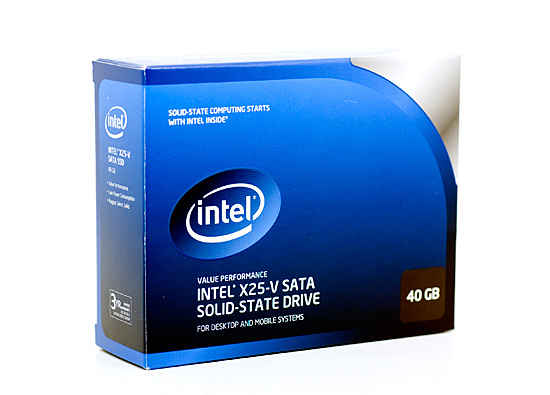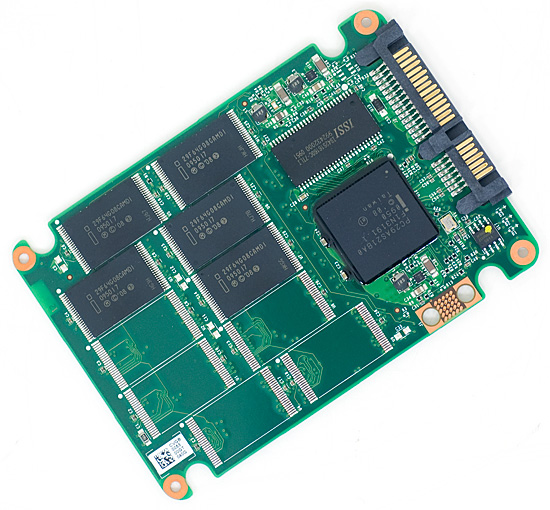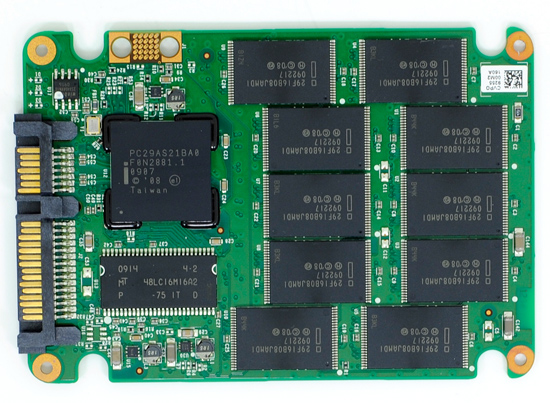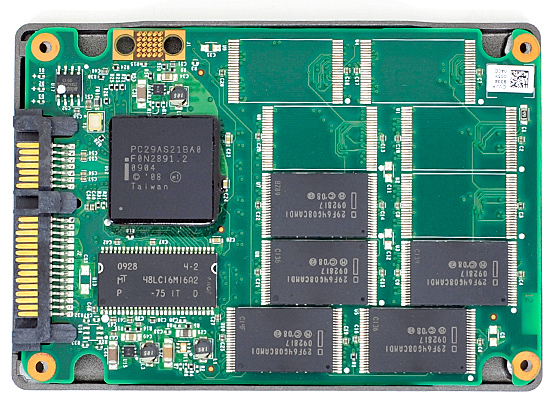Intel's X25-V & Kingston's 30GB SSDNow V Series: Battle of the $125 SSDs
by Anand Lal Shimpi on March 19, 2010 12:00 AM EST- Posted in
- Storage
V for Vende...Value
This is the first time I’ve actually received a retail boxed Intel SSD. The packaging actually mimics that of Intel’s boxed CPUs:

Inside the retail package you’ll find a full upgrade kit. You get a 3.5” mounting plate, a mini CD with an installation guide on it, one of those My SSD Rocks! stickers and the drive itself.

The X25-V ships in the same aluminum housing as the X25-M G2. Cracking it open reveals a bare side of the PCB:

Flipping it over we see the 5 x 8GB 34nm IMFT flash modules, the G2 controller and 32MB of PC133 SDRAM. The controller and SDRAM size/speed are identical to the 80 and 160GB G2s we reviewed last year.

Intel's X25-V PCB
With only half the channels populated, sequential write speed is about half of the X25-M G2 (~40MB/s vs. ~80MB/s). Remember that Intel’s controller uses free space as spare area, so with potentially less free space on the drive the 40GB X25-V will undoubtedly perform much worse than the 80GB or 160GB X25-Ms.

Intel's X25-M G2 PCB
In practice, the X25-V should perform very much like last year’s 40GB Kingston V Series Boot Drive. The two are identical minus official support for TRIM in the X25-V’s firmware.

Kingston's 40GB V Series Boot Drive PCB
Intel’s storage drivers (Intel RST 9.6) with TRIM support are expected to be available any day now so you’ll no longer have to rely on Microsoft’s AHCI drivers for TRIM.










78 Comments
View All Comments
Anand Lal Shimpi - Friday, March 19, 2010 - link
No, unfortunately it looks like the bracket keeps the drive centered, which positions the SATA connectors too far to the middle to work properly in 3.5" carriers like what Apple uses for the Mac Pro.Take care,
Anand
Drakino - Friday, March 19, 2010 - link
Thanks for the response. If you can pass some feedback to the manufacturers, can you let them know this is one of the big reasons I haven't jumped on a SSD yet? A SATA compliant 3.5 inch solution would be appreciated by those of us using cableless drive setups. I know HP shipped a few VoodooPC gaming rigs with similar drive bays.I'm still really tempted to pick one of these up, but not sure how I can get it in my system without just dangling the drive on the connector.
Nomgle - Wednesday, March 24, 2010 - link
See below - Icy Dock make two adaptors that'll fit your Mac Pro just fine :)vol7ron - Friday, March 19, 2010 - link
Anand,Though I'm still operating almost all my machines on XP, I thought you said you were going to start doing all your benchmarks in Win7.
I appreciate doing both in this example, but that's got to be a lot of time spent doing it on multiple machines.
vol7ron
PS
This article really interests me when thinking about building an HTPC. I know I'll need a lot of storage space - I hope to have 4TB worth - but having a quick, speedy, small drive would be a loading dream. Thanks for the review.
Itomerou - Friday, March 19, 2010 - link
I really enjoyed the article and am always impressed with the level of detail that is done when testing and comparing components. However, the only problem with this article is that when comparing queue depth and light/heavy workload averaging the results provides no value in so far as the distribution of IOPS is not normally distributed. Additionally, the fact that these drives are completely different in their drivers and priority addressing of queue requests to say that one drive is able to server requests faster depends on the fact that measurement of requests served fits the drives exact distribution of requests served. This is apparent with the charts of how each drive performs for sequential and random access. Finally, in order to make substantial claims confidence intervals must also be constructed otherwise how accurate are the results?On the otherhand I am still intrigued with the findings.
Zelog - Friday, March 19, 2010 - link
Look at the size of the kingston, it's tiny! Now you don't even need dedicated 2.5" space for the drive, making the htpc/laptop/net book even smaller. It is definitely worth its price in the right settings.GeorgeH - Friday, March 19, 2010 - link
That was my first thought, but with a slightly different angle. If Kingston made a custom form factor you could extend laptops with dual storage below ~15". In something like the M11x you could have one of these as a fast boot drive while using a big and slow HDD with aggressive power management to get more storage, faster storage, and longer battery life.(Yes, I'm aware of mini-PCIe (and other custom connection) SSDs for netbooks and other SFF devices, but the performance there is terrible.)
Shadowmaster625 - Friday, March 19, 2010 - link
Entry level is not $125. $125 is not "cheap" or "inexpensive".davepermen - Friday, March 19, 2010 - link
it's a cheap and inexpensive SSD, and definitely the most entry level ssd existing.and yeah, if you buy an entry level desktop (not an atom), you easily pay several 100$. investing 100 more to make it perform 'really fast', is the most cheap and inexpensive way to make it perform much better.
how would YOU invest that amount of money to boost up your pc? (laptops are a different story because there storage matters actually, in a pc, just let the old hdd be plugged in too)
casteve - Friday, March 19, 2010 - link
The OCZ 30GB Agility @ $119 wins the entry level contest over these two. $99 after MIR at newegg.